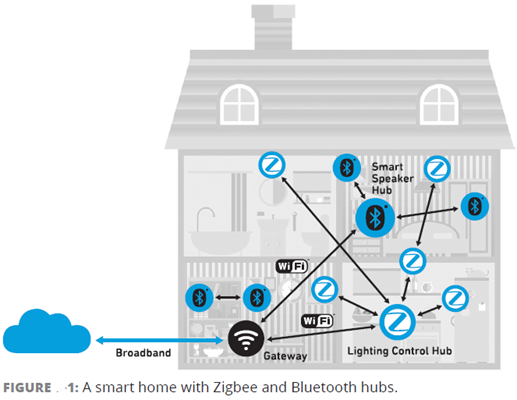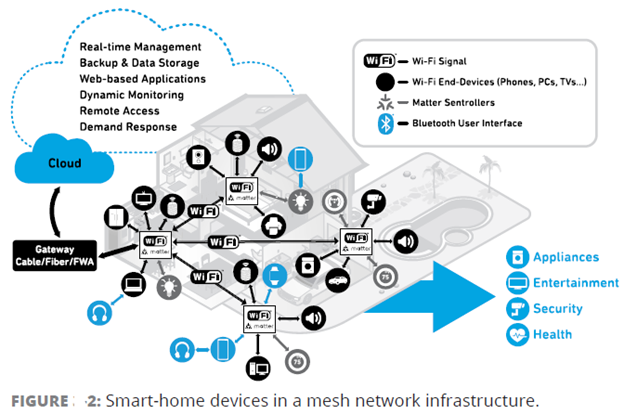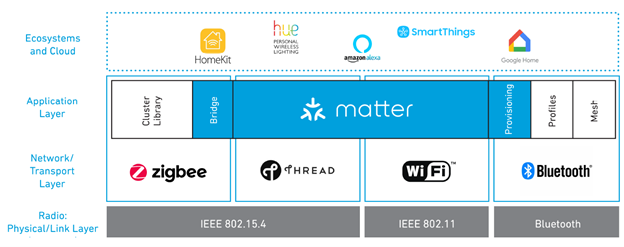By Tony Testa and Cees Links
Smart home technology has long been in a state of disarray – a confusion of myriad standard and non-standard systems, devices and applications that don't work and play well together. There's got to be a better way. And soon there will be.
The Trouble with Smart Homes
Technology fragmentation has clearly gotten in the way of the smart home's progress. Different IoT devices don't always communicate with each other, with some requiring their own app or network to communicate as shown in Figure 1. It's not unusual for early adopters' smartphones to be overstuffed with apps - one for lighting, another for security, a third for temperature control, and the list goes on. Likewise, their homes are overpopulated with sensors, to the point of needing one in each room for each application.

Ultimately, consumers want plug-and-play devices and networks that require minimal effort. Additionally, manufacturers struggle with choosing which standard will work and make them the most revenue. To satisfy both of these needs, a one-standard approach would be the best solution. Without this easy consumer and manufacturer solution, IoT device adoption and integration will proceed only gradually.
Enter Matter
The standard known as Matter is poised to unify today's fragmented smart home market, orchestrating wireless gateways, room-to-room extenders and smart devices running on a network of multi-standard connectivity throughout the home.
Here's how it came about: In March 2021, the Zigbee Alliance changed its name to the Connectivity Standards Alliance (CSA) to position itself as a trusted advocate of safe, interconnected IoT. Additionally in 2021, the CSA announced the brand of its new IoT protocol called Matter. Driven by industry leaders like Amazon, Apple, Google and Samsung, Matter provides interoperable control of the current patchwork of standards, including Wi-Fi, Thread, Bluetooth and Zigbee. The goal is to achieve essential interoperability of smart home ecosystems, devices and apps, along with simplified setups and built-in security measures.
Since 2021, the CSA has been seeking to accelerate Matter product development by using an open source approach to developing its standard's specifications and by taking the unusual step of offering a full software development kit (SDK) and testing tools for it. The CSA aims to deliver its SDK into the hands of design engineers in the second half of 2022. And the alliance says it could be stamping “Matter Certified” labels on smart home products shortly after that.
As a recent swell of major product announcements attests, ecosystems, devices and apps that support Matter are lining up at the starting gate. In addition, some product retailers are designing Matter-certified releases to include backward compatibility with older devices already in the home, while others are promising software upgrades or inexpensive bridges.
Matter was all the buzz around the Consumer Electronics Show in 2022. To give one example, Amazon has said that a software update to its Echo devices will let them start commissioning and controlling Matter devices soon after the standard is formally released. For developers, the company has ensured that no Amazon-specific SDK would be required to connect devices to its ecosystem; a Matter SDK will suffice. Another example came in May from IKEA, which says it will launch a “Matter ready” hub for its smart home products in October of 2022.
Wi-Fi Advances Make the Most of Matter
Matter and high-performing tri-band Wi-Fi mesh networks are expected to yield ongoing innovation in the smart home. As shown below in Figure 2, today's Wi-Fi home and business architectures are moving to distributed Wi-Fi or Wi-Fi Easy Mesh. They're based on a “pod per room” architecture and are becoming more commonplace.

In parallel with the work on Matter specifications, Wi-Fi standards have been advancing rapidly. They're delivering increasing room-to-room connectivity in a mesh setup of gateways and extenders that handle higher and higher speeds with lower and lower latency.
Wi-Fi 6E is new in the market today, but all of the forward-looking design activity is already moving to the next standard, which is Wi-Fi 7.
Both 6E and 7 can strengthen the mesh Wi-Fi capability and backhaul that Matter rides on in the smart home. Part of that strength comes from recently allocated spectrum that facilitates very high throughput. With Wi-Fi 6E and Wi-Fi 7, smart homes will keep getting better at video streaming, gaming, augmented reality - and go on to enable other innovations yet to be conceived.
Liberating Design Engineering
Matter will not only make consumers' lives easier but will also help system design engineers design faster and simpler - in addition to giving product retailers more confidence in the smart home products they sell.
Last year , a Qorvo white paper titled "Wi-Fi 6 and Matter: The Real Plug and Play Smart Home" laid out the technical foundations of Matter. Essentially, Matter resides in a layer of the technology stack between the network/transport and application layers, employing the various connectivity standards mentioned above to suit different purposes, as shown in Figure 3.

Figure 3: Networking ecosystems cohabitate – Matter is an aggregation standard that brings together existing IoT standards.
Matter's orchestration of smart home ecosystems, devices and applications calls on multiple connectivity standards in a whole-home mesh setup, like this:
- Connecting to a fiber optic or other public network, via a Wi-Fi gateway in the home.
- Relying on Wi-Fi to connect smart devices that use streaming data, such as smart TVs, across a mesh configuration of pods in every room.
- Switching over to the Thread standard to link battery- operated devices that send small amounts of data, such as sensors.
- Using Bluetooth for device setup, for instance, enabling a smartphone screen and keyboard to facilitate the configuration of a smart doorbell.
- Migrating the Zigbee smart home interoperability standard under the Matter banner.
While Matter will not support all device types upon its release, as of 2022 the CSA says it will cover these:
- Lighting and electrical such as bulbs and outlets
- HVAC controls such as thermostats
- Access controls such as door locks
- Safety and security sensors
- Window shades
- Televisions
- Bridges
Post-launch work will add these types of devices, according to the CSA:
- Cameras
- Energy management
- Robot vacuums
- Appliances
As Matter creates convergence among all these systems, devices and standards, engineers are breathing a sigh of relief. Matter promises to lift a burden they have labored under at every step in the smart home's development, by taming complexity and dispelling the nagging uncertainty about which standards to support and to what level. In short, engineers feel their chance of success has significantly increased.
As the CSA puts it: "With a single development path to the largest addressable market and more reliable user experiences, developers can focus their resources on innovation and increase return on investment."
